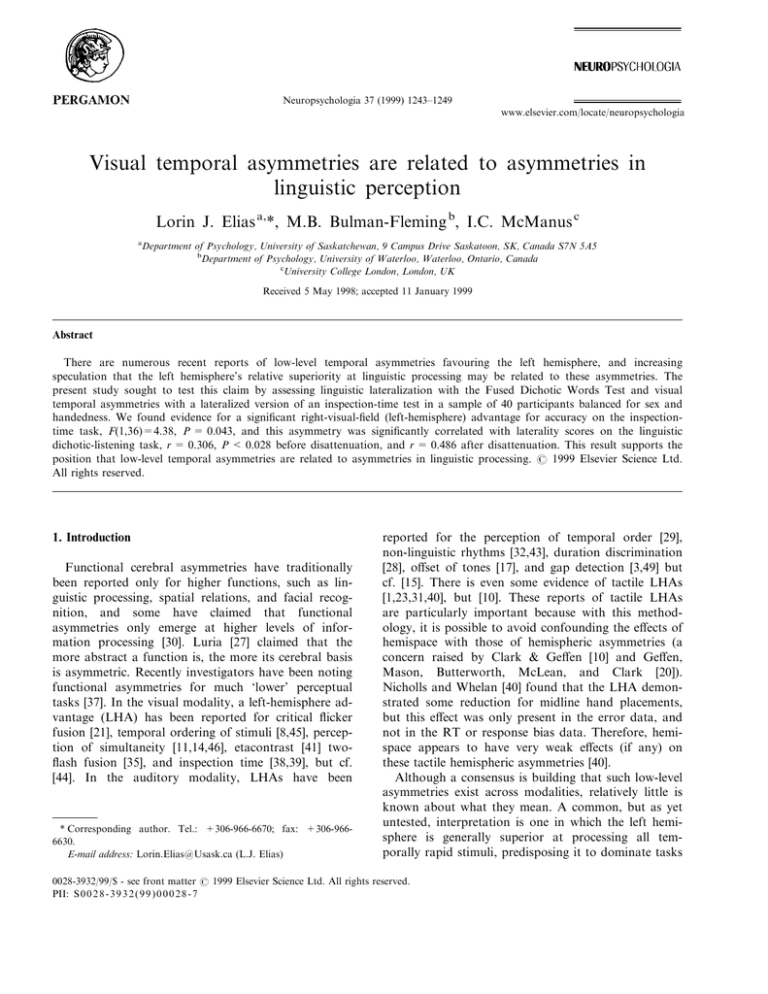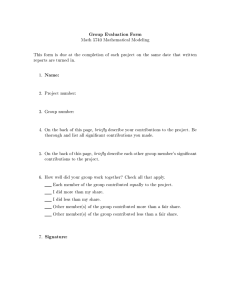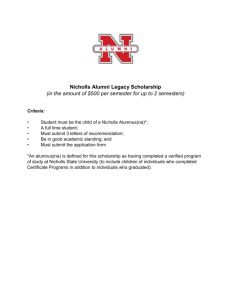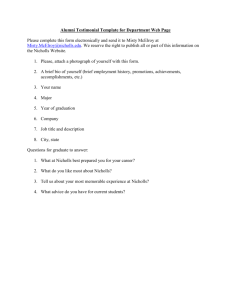
Neuropsychologia 37 (1999) 1243±1249
www.elsevier.com/locate/neuropsychologia
Visual temporal asymmetries are related to asymmetries in
linguistic perception
Lorin J. Elias a,*, M.B. Bulman-Fleming b, I.C. McManus c
a
Department of Psychology, University of Saskatchewan, 9 Campus Drive Saskatoon, SK, Canada S7N 5A5
b
Department of Psychology, University of Waterloo, Waterloo, Ontario, Canada
c
University College London, London, UK
Received 5 May 1998; accepted 11 January 1999
Abstract
There are numerous recent reports of low-level temporal asymmetries favouring the left hemisphere, and increasing
speculation that the left hemisphere's relative superiority at linguistic processing may be related to these asymmetries. The
present study sought to test this claim by assessing linguistic lateralization with the Fused Dichotic Words Test and visual
temporal asymmetries with a lateralized version of an inspection-time test in a sample of 40 participants balanced for sex and
handedness. We found evidence for a signi®cant right-visual-®eld (left-hemisphere) advantage for accuracy on the inspectiontime task, F(1,36)=4.38, P = 0.043, and this asymmetry was signi®cantly correlated with laterality scores on the linguistic
dichotic-listening task, r = 0.306, P < 0.028 before disattenuation, and r = 0.486 after disattenuation. This result supports the
position that low-level temporal asymmetries are related to asymmetries in linguistic processing. # 1999 Elsevier Science Ltd.
All rights reserved.
1. Introduction
Functional cerebral asymmetries have traditionally
been reported only for higher functions, such as linguistic processing, spatial relations, and facial recognition, and some have claimed that functional
asymmetries only emerge at higher levels of information processing [30]. Luria [27] claimed that the
more abstract a function is, the more its cerebral basis
is asymmetric. Recently investigators have been noting
functional asymmetries for much `lower' perceptual
tasks [37]. In the visual modality, a left-hemisphere advantage (LHA) has been reported for critical ¯icker
fusion [21], temporal ordering of stimuli [8,45], perception of simultaneity [11,14,46], etacontrast [41] two¯ash fusion [35], and inspection time [38,39], but cf.
[44]. In the auditory modality, LHAs have been
* Corresponding author. Tel.: +306-966-6670; fax: +306-9666630.
E-mail address: Lorin.Elias@Usask.ca (L.J. Elias)
reported for the perception of temporal order [29],
non-linguistic rhythms [32,43], duration discrimination
[28], oset of tones [17], and gap detection [3,49] but
cf. [15]. There is even some evidence of tactile LHAs
[1,23,31,40], but [10]. These reports of tactile LHAs
are particularly important because with this methodology, it is possible to avoid confounding the eects of
hemispace with those of hemispheric asymmetries (a
concern raised by Clark & Geen [10] and Geen,
Mason, Butterworth, McLean, and Clark [20]).
Nicholls and Whelan [40] found that the LHA demonstrated some reduction for midline hand placements,
but this eect was only present in the error data, and
not in the RT or response bias data. Therefore, hemispace appears to have very weak eects (if any) on
these tactile hemispheric asymmetries [40].
Although a consensus is building that such low-level
asymmetries exist across modalities, relatively little is
known about what they mean. A common, but as yet
untested, interpretation is one in which the left hemisphere is generally superior at processing all temporally rapid stimuli, predisposing it to dominate tasks
0028-3932/99/$ - see front matter # 1999 Elsevier Science Ltd. All rights reserved.
PII: S 0 0 2 8 - 3 9 3 2 ( 9 9 ) 0 0 0 2 8 - 7
1244
L.J. Elias et al. / Neuropsychologia 37 (1999) 1243±1249
Fig. 1. The pi stimulus (a) and its backward mask (b).
requiring great temporal precision, such as linguistic
tasks and skilled unimanual behaviours [28]. If this
position is correct, using a within-subjects experimental
design, the hemisphere that is superior at perceiving
rapid temporal events should be the same hemisphere
superior at linguistic tasks.
The inspection-time task was ®rst described by
Vickers [47,48] and is based on the `accumulator'
model of perception and decision making. This model
suggests that there are absolute temporal limitations
on an individual's rate of assimilation of stimuli from
the environment. To measure the rate at which stimuli
could be assimilated, Vickers [47,48] developed a task
in which the stimuli (referred to as `pi' ®gures), consisting of an inverted U-shaped ®gure with one `leg'
shorter than the other, were presented and participants
were required to judge which leg was shorter (see Fig.
1). By varying the exposure duration of the pi ®gure
and examining the relative performance of a subject at
the dierent durations, one can obtain a measure of
`inspection time', de®ned as the exposure duration at
which a subject can correctly identify the shorter leg
on 90% of the stimulus presentations.
Nicholls and Cooper [39] modi®ed the original
inspection time task to allow separate presentations of
the pi stimulus to the left visual ®eld (LVF) and right
visual ®eld (RVF). They found that pi stimuli presented to the RVF were processed signi®cantly more
quickly than those presented to the LVF, as revealed
by overall accuracy as well as separate estimates for
inspection time for each visual ®eld. Out of concern
that the RVF advantage on the task might be related
to the potentially categorical nature of the task,
Nicholls and Atkinson [38] further modi®ed the inspection time task, varying the diculty of the task (but
not the categorical nature of the judgements) by varying exposure duration (time task) or the degree to
which one line was shorter than the other (length
task), in eect making the categorical part of the task
more dicult. Therefore, the temporal and categorical
components of the inspection time could be examined
separately. Nicholls and Atkinson [38] found a signi®cant RVF-LHA for the time task, but no such asymmetry for the length task. Therefore, the RVF
advantage on the task does not appear to be related to
the categorical judgements it requires.
However, other investigators have failed to replicate
the RVF-LHA for inspection-time [34,44]. The Sadler
and Deary [44] study diered from that of Nicholls
and Cooper [39] and Nicholls and Atkinson [38] in a
number of respects. Sadler and Deary [44] presented pi
stimuli tachistoscopically (rather than using a computer monitor), used a modi®ed masking stimulus (in an
attempt to reduce apparent movement eects),
employed a wider range of stimulus onset asynchronies
(SOAs), tested participants over a period of ®ve days,
and required verbal (rather than button-press) responses at the subject's leisure, not recording reaction
time. Contrary to their hypothesis that the RVF-LHA
would disappear with practice, they found no evidence
of an RVF-LHA on the initial testing days, but a nonsigni®cant RVF-LHA emerging by day 5. It is unclear
which dierences between the two versions of the bilateral inspection time tasks could be responsible for the
discrepancy between the results of these studies.
The present study seeks to investigate the possible
relation between performance asymmetries on a visual
inspection-time task and linguistic lateralization as
measured by the Fused Dichotic Words Test (FDWT)
developed by Wexler and Halwes [50]. We chose the
FDWT as a test of linguistic laterality because it has
performed very well in validation studies [51], and
serves as a rapid, inexpensive, and non-invasive test of
linguistic lateralization. The lateralized inspection-time
paradigm described by Nicholls and Cooper [39] and
Nicholls and Atkinson [38] was chosen because a
cross-modal (i.e. auditory performance compared with
visual performance) comparison would be less vulnerable to potential confounds of two tasks testing the
same modality (such as higher sensitivity of one ear
aecting two auditory tasks). Studies of low-level temporal asymmetries in the visual modality are also preferable because the visual system demonstrates greater
initial contralaterality in its projections than does the
auditory system. The RVF-LHA reported for studies
of visual temporal asymmetries does not seem to be related to the potentially categorical nature of the tasks
[38] or attentional biases [36].
Because the methodology of our inspection-time
task was closely modelled after that described by
Nicholls and Cooper [39] and Nicholls and Atkinson
[38], we expected to replicate their results. Further, we
expected that the RVF-LHA on the visual inspection
time would be signi®cantly positively correlated with
linguistic asymmetries on the dichotic-listening task.
Because language laterality appears to vary with both
hand preference [26,42] and foot preference [13,16], we
recruited participants with consistently right or consistently left lateral preferences. We expected that left-
L.J. Elias et al. / Neuropsychologia 37 (1999) 1243±1249
handed/footed participants would be less likely to exhibit a RVF-LHA on the inspection-time task.
2. Method
2.1. Participants
Fifty one undergraduate students participated in this
experiment for six dollars remuneration or course
credit. The data from 11 participants had to be
removed from the analysis because they could not
complete the inspection-time task signi®cantly above
chance performance. Therefore, the data from 40 participants were included in the analysis. Participants
were selectively recruited to include an equal number
of males and females within an equal number of lefthanders and right-handers. Further, only individuals
who were consistently right-handed and right-footed
or both left-handed and left-footed were recruited for
the experiment. All participants were students at the
University of Waterloo, and had normal hearing and
normal or corrected-to-normal vision at the time of
the experiment.
2.2. Materials
To con®rm the consistency and direction of an individual's hand and foot preferences, all participants
completed the `Waterloo Handedness QuestionnaireÐ
Revised' (WHQ-R) and the `Waterloo Footedness
QuestionnaireÐRevised' (WFQ-R).
Language lateralization was assessed using the
FDWT developed by Wexler and Halwes [50]. The test
consists of 15 dichotic pairs of rhyming single-syllable
words (e.g. coat/goat) that vary only in the initial phoneme. Stimuli were natural speech signals that were
digitized on a PDP-2/24 computer and recorded on
audio cassette by T. Halwes at Precision Neurometrics.
The tape was played on a Sony Professional Walkman
(model WM-D6C) through JVC (model HA-D500)
earphones with circumaural cushions. Each stimulus
pair was presented four times in each of two possible
stimulus arrangements (Stimulus A in left ear or
Stimulus A in right ear) for a total of 120 trials. Four
blocks of 30 trials were presented, and earphones were
reversed after the ®rst and third blocks to control for
mechanical defects in the testing equipment. Test trials
were preceded by 30 monaural practice trials in which
each stimulus was presented once to each ear. During
the testing, participants indicated which word they
heard by circling it from among four possibilities presented in pseudo-random order on an answer sheet:
the word in the left ear; the word in the right ear, and
two rhyming distractors.
The inspection-time task was very similar to that
1245
employed by Nicholls and Atkinson [38]. The test was
administered via an IBM compatible 386/SX computer, interfaced with a Magnavox CM9039 Color VGA
Monitor. At a viewing distance of 50 cm (held constant by employing a chin rest), the pi ®gures occupied
2.38 of visual angle in width and 3.08 in height. The
shorter `leg' of the pi ®gure occupied 1.38 of visual
angle. The stimuli were displayed in black against a
white background.
At 500 ms before each trial, a central ®xation cross
measuring 0.58 of visual angle was presented. The pi
®gures were presented randomly on either the left or
right side of the ®xation cross, with the nearest leg
2.38 from the central point, and the outer leg a further
2.38 away. The pi ®gure was presented for 40, 60, 80,
100, or 120 ms, after which a similar backward mask
with both legs of equal length was presented. A new
trial was initiated 1000 ms after the subject responded.
Fig. 1 shows the pi stimulus and the backward mask.
Each subject completed 196 trials of this task,
divided unequally between the ®ve dierent exposure
durations: 28 trials at 40 ms, 28 trials at 60 ms, 56
trials at 80 ms, 56 trials at 100 ms, and 28 trials at 120
ms. Pilot testing using the exposure durations (20±100
ms) employed by Nicholls and Atkinson [38] indicated
that exposure times of both 20 ms and 40 ms were vulnerable to ¯oor eects, so to avoid the possibility of a
large number of participants performing at chance on
the task, the exposure durations used by Nicholls and
Atkinson [38] were increased by 20 ms for the present
study. Twice as many trials were presented at the 80
and 100 ms durations because pilot testing indicated
that they were the least vulnerable to ¯oor and ceiling
performance eects. The testing sessions were broken
up into seven blocks of 28 trials. Within each block,
representative proportions of the possible combinations of stimulus duration, side of the shorter leg on
the pi ®gure, and side of presentation were included.
These three parameters were randomized within each
block to prevent the participants from being able to
predict the location and type of the next trial.
Participants responded by pressing one of four keys
on a keyboard, with their index and middle ®ngers of
each hand, using two keys on their right side for stimuli that fell in their right visual ®eld and vice versa for
stimuli presented to their left visual ®eld. Using this
spatially mapped arrangement, when responding correctly, participants pressed the key that corresponded
to the location of the shorter leg of the pi ®gure.
Prior to beginning the test, participants were
instructed to keep their chin ®rmly in the chin rest,
and that they should be very careful to keep their eyes
®xated on the cross in the middle of the screen to
maximize their performance, because the side of presentation was randomized. Accuracy of response, rather
than response speed, was emphasized to the subject.
1246
L.J. Elias et al. / Neuropsychologia 37 (1999) 1243±1249
Participants were encouraged to take breaks between
blocks to facilitate concentration, and short cartoons
were presented between blocks. The inspection time
task took between 15 and 20 min to complete.
2.3. Procedure
To enable the recruitment of an equal number of
participants from each handedness/footedness group
and sex, a screening questionnaire was administered to
600 undergraduate students. Participants who could
not complete the visual inspection-time task signi®cantly above chance were replaced with someone from
the same handedness, footedness, and sex group. First,
each participant completed the WHQÐR, followed by
the WFQÐR. Then, 120 trials of the FDWT were
completed. After completion of the dichotic task, participants performed the inspection-time task. The
entire testing procedure took approximately 45 min.
2.4. Scoring analysis
The FDWT data were scored using a log-linear
analysis procedure described by Grimshaw, McManus,
and Bryden [22], which calculates a laterality index
(l) controlling for eects of stimulus dominance (the
l index is analogous to the l index described by
Bryden and Sprott [7]). Ear advantages are calculated
by ®tting a model that includes every relevant eect
except the `response' `stimulus arrangement' interaction (one would include main eects of `stimulus
pair', `response', `stimulus arrangement', and the
`stimulus pair' `stimulus arrangement' interaction)
and note the likelihood ratio Chi-square test statistic.
Next, one must ®t a second model that includes every
eect in the ®rst model in addition to the `response' `stimulus arrangement' interaction. The parameter estimates provided for each subject's `response'
by `stimulus arrangement' interaction provide an index
of lateralization that is unbounded, approximately normally distributed, unconstrained by accuracy, and that
controls for the eects of stimulus dominance. Positive
l scores are indicative of a right-side advantage, and
negative scores indicate left-side advantages.
The ®rst (practice) block of the inspection-time task
was not scored, but the data from the remaining six
blocks were scored using the l log-linear procedure
described by Bryden and Sprott [7]. The l index=loge
[(right hits left misses)/(left hits right misses)]. This
index is unbounded, approximately normally distributed, and unconstrained by accuracy. In addition to
scoring the inspection-time data with the l index, it
was also scored in terms of percent correct and median
reaction time for each SOA within each visual ®eld.
Fig. 2. Percent correct for pi presentations to RVF and LVF across
the ®ve SOAs.
3. Results
3.1. Inspection-time task
The accuracy data on the inspection-time task were
analyzed using a repeated-measures ANOVA, with
within-subjects variables of visual ®eld (left or right)
and duration of exposure (40, 60, 80, 100, or 120 ms),
and between-subjects variables of hand/foot preference
(left or right) and sex (male or female). There was a
signi®cant main eect of visual ®eld (see Fig. 2), with
participants more accurately detecting the shorter leg
in the RVF, F(1,36)=4.38, P = 0.043. There was also
a signi®cant main eect of exposure duration in which
longer stimulus presentations were identi®ed more
accurately, F(4,33)=45.36, P < 0.001. To our surprise,
there was also a signi®cant main eect of sex: males
were signi®cantly more accurate than females,
F(1,36)=5.79, P = 0.021. There were no signi®cant interactions between any of the variables.
Despite the non-signi®cant interaction between sex
and visual ®eld of presentation, F(1,36) < 1, the possibility that the two groups might dier in the strength
of visual-®eld asymmetry warranted investigation
because the laterality data of the two groups could be
confounded by the signi®cant dierences in performance [7]. Therefore, a log-odds ratio laterality index,
l=loge[(right misses left hits)/(right hits left
misses)], which avoids the confounds of performance
eects, was calculated for each individual. Although
males tended to exhibit slightly greater RVF advantages than females, this eect was not signi®cant,
t(38)=0.54, P = 0.596.
The reaction time (RT) data did not reveal any
visual-®eld asymmetry, F(1,36) < 1, and the sex dier-
L.J. Elias et al. / Neuropsychologia 37 (1999) 1243±1249
1247
Fig. 3. Scatterplot of l scores on the FDWT vs l scores on the inspection time task.
ence noted in the accuracy data did not reach signi®cance, F(1,36)=2.71, P = 0.11. The only signi®cant
eect in RT was one of exposure duration,
F(4,33)=39.16, P < 0.001, wherein participants
responded faster to longer exposures of the pi ®gure.
3.2. Fused Dichotic Words Test
As expected, most participants (30/40) exhibited
right-ear advantages (REAs) on the FDWT. Although
left-handed/footed participants tended to exhibit lower
l scores (indicating a smaller REA) than righthanded/footed participants, this eect was non-signi®cant, F(1,39) < 1, and there was no sex eect or interaction between these variables.
As hypothesized, l scores on the FDWT and the
inspection-time task were signi®cantly positively correlated, r = 0.306, P = 0.028 (one-tailed). However,
because the correlation of interest is that between the
latent variables of inspection-time and dichotic-listening, and the correlation above is based on measured
values (incorporating measurement error), the correlation must be disattenuated for error. Split-half reliability of the inspection-time task in the present
experiment was r = 0.482. The FDWT has proven
considerably more reliable in our laboratory, demonstrating split-half reliability of r = 0.823. Therefore,
after disattenuation, the correlation increases to
r = 0.486 (Fig. 3).
To further investigate the relation between perform-
ance on these two tests, participants were classi®ed as
either left- or right-hemisphere advantaged (LHA or
RHA) on each task to enable odds-ratio testing.
Strictly speaking, if both tests are measuring the same
underlying process, no individual should exhibit an
LHA on one task and an RHA on another. In other
words, given that an individual exhibits an REA
(LHA) on the FDWT, the odds of his or her also
showing an LHA (as opposed to an RHA) on the
inspection-time task should be high whereas those
odds given an RHA on the FDWT should be very
low. The ratio of the former odds to the latter, then,
should be high. The natural log of odds ratio is easily
tested for signi®cance using a z-test [6]. For the present
data, after dichotomizing participants' scores on both
measures, the resulting odds ratio was not signi®cant.
Thus, individuals were no more likely to show an
LHA on the inspection-time task if they had shown an
LHA on the dichotic task than if they had shown an
RHA on the dichotic task. The odds ratio, then,
although>1 as would be predicted, is not signi®cant.
4. Discussion
The present study provides clear support for the
claim that low-level temporal asymmetries are related
to linguistic asymmetries. Similar to the results of
Nicholls and Cooper [39] and Nicholls and Atkinson
[38], analysis of our data revealed a signi®cant RVF-
1248
L.J. Elias et al. / Neuropsychologia 37 (1999) 1243±1249
LHA for a lateralized visual inspection-time task, and
this visual processing asymmetry was signi®cantly correlated with linguistic asymmetry measured with the
dichotic-listening paradigm.
Although the correlation between these two tests
may seem low (r = 0.306 before disattenuation,
r = 0.486 after disattenuation), it becomes more
impressive when one considers the strength of crossmodal correlations between visual and auditory linguistic laterality tests reported in the literature. Despite
the fact that these tests are meant to tap similar (if not
identical) processes, many investigators have failed to
®nd any signi®cant positive correlation between these
measures, and some have even found weak negative
correlations [4,5,18,19,25,30]. On those occasions when
signi®cant positive correlations are obtained between
the measures, they are usually rather low. For
example, Hines and Satz [24] found modest correlations, which were only signi®cant in their righthanded
participants
(r = 0.39).
Conversely,
Dagenbach [12] found signi®cantly larger cross-modal
correlations for his left-handed participants (r = 0.302)
than for his right-handed participants (r=ÿ0.138). In
light of the relatively poor relation between visual
half-®eld tests of linguistic laterality and dichotic-listening tasks, the signi®cant positive correlation
between inspection-time asymmetries and laterality
scores on the FDWT in the present study provides evidence that the two tasks may be relying on a common
process.
The absence of a clear RVF-LHA in the RT data
despite a signi®cant eect on accuracy is puzzling, but
not unprecedented. Nicholls and Atkinson [38] also
found a signi®cant RVF-LH advantage in accuracy
but no such advantage in RT on a lateralized inpsection task. There is no evidence of a speed/accuracy tradeo in the present study. The discrepancy between
the accuracy and RT results may be due to decreased
power in studying reaction time, because of much
greater individual variation. Alternatively, the eect
could have been mediated by the experimental instructions, where accuracy, not response speed, was stressed
to the participants as the critical part of the task.
We predicted that there would be signi®cant eects
of lateral preference in the RVF-LHA exhibited in the
inspection-time task. Although the two lateral preference groups diered in the predicted direction, this
eect did not approach statistical signi®cance.
Similarly, the left-handers exhibited non-signi®cantly
weaker REAs than the right-handers on the dichotic
task. The present study may not have had enough
power to detect dierences between the handedness
groups.
The sex dierence in accuracy on the inspection time
was unexpected. Although some authors have
suggested that inspection time is signi®cantly related to
intelligence [2,9,33,52], it seems unlikely that the males
participating in this study were signi®cantly more intelligent than the females. The physical nature of the task
may be more to blame for the sex dierence. When
completing the task, participants have to quickly press
buttons in response to rapidly ¯ashing stimuli on a
computer screen, a task not entirely unlike playing a
video game. Because males seem to be more likely to
be well practiced at such games and performance on
the inspection-time task improves signi®cantly with
practice [44], the greater practice experienced by males
on similar tasks might account for the observed sex
dierence in the present study.
Given that visual asymmetries as measured with the
inspection-time paradigm appear to be related to linguistic asymmetries, this suggests the possibility that
other low-level temporal asymmetries will exhibit a
similar relatedness. Further, the results of the present
study lend support to the position that the left hemisphere is usually superior at processing all temporally
rapid stimuli, predisposing it to dominate tasks requiring great temporal precision, such as linguistic tasks
and skilled unimanual behaviours [28].
Acknowledgements
This experiment was supported by a fellowship to
L.J. Elias by the Natural Sciences and Engineering
Research Council of Canada (NSERC). The authors
wish to thank Murray J. Guylee for his help and
enthusiasm with this project.
References
[1] Bakker DJ, Van der Kleij PCM. Development of lateral asymmetry in the perception of sequentially touched ®ngers. Acta
Psychologica 1978;42:357±65.
[2] Brand CR, Deary IJ. Intelligence and inspection time. In:
Eysenck HJ, editor. A Model for Intelligence. New York:
Springer-Verlag, 1982. p. 133±48.
[3] Brown S, Nicholls MER. Hemispheric asymmetries for the temporal resolution of brief auditory stimuli. Perception and
Psychophysics 1997;59(3):442±7.
[4] Bryden MP. Tachistoscopic recognition, handedness, and cerebral dominance. Neuropsychologia 1965;3:1±8.
[5] Bryden MP. Perceptual asymmetry in vision: Relation to handedness, eyedness, and speech lateralization. Cortex 1973;9:418±
35.
[6] Bryden MP, McManus IC, Bulman-Fleming MB. GBG, BMB,
R & L, X & Y. . .Reply to Commentaries. Brain and Cognition
1994;26:312±26.
[7] Bryden MP, Sprott DA. Statistical determination of degree of
laterality. Neuropsychologia 1981;19:571±81.
[8] Carmon A, Nachshon I. Eects of unilateral brain damage on
the perception of temporal order. Cortex 1971;7:410±8.
[9] Chaiken SR. Two models for an inspection time paradigm:
Processing distraction and processing speed versus processing
speed and asymptotic strength. Intelligence 1993;17:257±83.
L.J. Elias et al. / Neuropsychologia 37 (1999) 1243±1249
[10] Clark CR, Geen GM. Hemispheric equivalence for simultaneity judgements of somatosensory stimuli. Cognitive
Neuropsychology 1990;7:311±27.
[11] Corballis MC. Hemispheric interactions in temporal judgements
about spatially separated stimuli. Neuropsychology 1996;10:42±
50.
[12] Dagenbach D. Subject variable eects in correlations between
auditory and visual language processing asymmetries. Brain and
Language 1986;28:169±77.
[13] Day LB, MacNeilage PF. Postural asymmetries and language
lateralization in humans (Homo sapiens). Journal of
Comparative Psychology 1996;110:88±96.
[14] Efron R. The eect of handedness on the perception of simultaneity and temporal order. Brain 1963;86:261±83.
[15] Efron R, Yund EW, Nichols DR, Crandall PH. An ear asymmetry for gap detection following anterior temporal lobectomy.
Neuropsychologia 1985;23:43±50.
[16] Elias LJ, Bryden MP. Footedness is a better predictor than
handedness of language lateralization. Laterality 1998;3(1):41±
51.
[17] Emmerich DS, Pitchford LJ, Joyce CM, Coppell SM. Laterality
eects in response to osets of tonal stimuli. Neuropsychologia
1981;19:227±34.
[18] Fennell EB, Bowers D, Satz P. Within-modal and cross-modal
reliabilities of two laterality tests. Brain and Language
1977;4:63±9.
[19] Fennell EB, Bowers D, Satz P. Within-modal and cross-modal
reliabilities of two laterality tests among left-handers. Perceptual
and Motor Skills 1977;45:451±6.
[20] Geen G, Mason C, Butterworth P, McLean S, Clark CR.
Tactile simultaneity within and between the hemispheres: The
eects of hemispace. Cognitive Neuropsychology 1996;13:257±
76.
[21] Goldman PS, Lodge A, Hammer LR, Semmes J, Mishkin M.
Critical ¯icker frequency after unilateral temporal lobectomy in
man. Neuropsychologia 1968;6:355±66.
[22] Grimshaw GM, McManus IC, Bryden MP. Controlling for
stimulus dominance in dichotic listening tests: A modi®cation of
lambda. Neuropsychology 1994;8:278±83.
[23] Hammond GR. Finer temporal acuity for stimuli applied to the
preferred hand. Neuropsychologia 1981;19:325±9.
[24] Hines D, Satz P. Cross-modal asymmetries in perception related
to asymmetry in cerebral function. Neuropsychologia
1974;12:234±47.
[25] Kim H, Levine SC. Variations in characteristic perception
asymmetry: Modality speci®c and modality general components.
Brain and Cognition 1992;19:21±47.
[26] Lake DA, Bryden MP. Handedness and sex dierences in hemispheric asymmetry. Brain and Language 1976;3:266±82.
[27] Luria AR. The Working Brain. London: Penguin, 1973.
[28] Mills LM, Rollman GB. Left hemisphere selectivity for processing duration in normal subjects. Brain and Language
1979;7:320±35.
[29] Mills L, Rollman GB. Hemispheric asymmetry for auditory perception of temporal order. Neuropsychologia 1980;18:41±7.
[30] Moscovitch M. Information processing and the cerebral hemispheres. In: Gazzaniga MS, editor. Handbook of Behavioural
Neurobiology, vol. 2. New York: Plenum Press, 1979. p. 379±
446.
[31] Nachshon I, Carmon A. Hand preference in sequential and
spatial discrimination tasks. Cortex 1975;11:123±31.
1249
[32] Natale M. Perception of nonlinguistic auditory rhythms by the
speech hemisphere. Brain and Language 1977;4:32±44.
[33] Nettelbeck T. Inspection time and intelligence. In: Vernon PA,
editor. Speed of Information Processing and Intelligence. New
Jersey: Ablex Publishing, 1987. p. 295±346.
[34] Nettelbeck T, Hirons A, Wilson C. Mental retardation, inspection time, and central attentional impairment. American Journal
of Mental De®ciency 1984;89:91±8.
[35] Nicholls MER. Hemispheric asymmetries for temporal resolution: A signal detection analysis of threshold and bias.
Quarterly Journal of Experimental Psychology 1994;47A:291±
310.
[36] Nicholls MER. The non-contribution of attentional biases to
visual ®eld asymmetries for temporal discrimination.
Neuropsychologia 1994;32:209±20.
[37] Nicholls MER. Temporal Processing Asymmetries between the
cerebral hemispheres: Evidence and implications. Laterality
1996;1:97±137.
[38] Nicholls MER, Atkinson J. Hemispheric asymmetries for an
inspection time task: A general left hemisphere temporal advantage? Neuropsychologia 1993;31:1181±90.
[39] Nicholls MER, Cooper CJ. Hemispheric dierences in the rates
of information processing for simple non-verbal stimuli.
Neuropsychologia 1991;29:677±84.
[40] Nicholls M.E.R., Whelan R.E., Hemispheric asymmetries for
the temporal resolution of brief tactual stimuli, Journal of
Clinical and Experimental Neuropsychology 1998;20:445±56.
[41] Oscar-Berman M, Goodglass H, Goldstein D. Perceptual laterality and iconic recognition of visual materials by Korsako
patients and normal adults. Journal of Comparative and
Physiological Psychology 1973;82:316±21.
[42] Rasmussen T, Milner B. The role of early left brain injury in
determining lateralization of cerebral speech functions. Annals
of the New York Academy of Sciences 1977;299:355±69.
[43] Robinson GM, Solomon DJ. Rhythm is processed by the
speech hemisphere. Journal of Experimental Psychology
1974;102:508±11.
[44] Sadler AJ, Deary IJ. Cerebral asymmetries in inspection time?
Neuropsychologia 1996;34:283±95.
[45] Swisher I, Hirsh IJ. Brain damage and the ordering of two temporally successive stimuli. Neuropsychologia 1972;10:137±52.
[46] UmiltaÁ C, Stadler M, Trombini G. The perception of temporal
order and the degree of eccentricity of the stimuli in the visual
®eld. Studia Psychologica 1973;15:130±9.
[47] Vickers D. Evidence for an accumulator model of psychophysical discrimination. Ergonomics 1970;13:37±58.
[48] Vickers D. Decision Processes in Visual Perception. New York:
Academic Press, 1979.
[49] Vroon PA, Timmers H, Tempelaars S. On the hemispheric representation of time. In: Dornic S, editor. Attention and
Performance VI: Procedings of the Sixth International
Symposium on Attention and Performance. Hillsdale, NJ:
Erlbaum, 1977. p. 231±45.
[50] Wexler BE, Halwes T. Increasing the power of dichotic
methods: The fused rhymed words test. Neuropsychologia
1983;21:59±66.
[51] Zatorre RJ. Perceptual asymmetry on the dichotic fused words
test and cerebral speech lateralization determined by the carotid
sodium amytal test. Neuropsychologia 1989;27:1207±19.
[52] Zhang Y. Inspection time correlation with IQ in Chinese students. Personality and Individual Dierences 1991;12:217±9.





